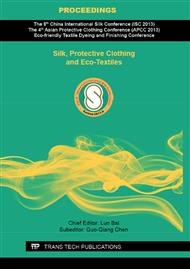p.588
p.593
p.601
p.607
p.613
p.617
p.623
p.630
p.634
Standard System Analysis on Protective Clothing Against Heat and Flame
Abstract:
Firefighter's protective clothing provide protection for the firefighter's torso, neck, arms, and legs, but excluding the head, hands. The performance index for textile burning behaviour include afterflame time, afterglow time, damaged length, damaged area, dimensional stability to heat, ignition time and so on. The purpose of Standard is to provide minimum performance requirements for protective clothing for firefighters, whilst fighting fires. Within national standard GB 8965.1-2009 protective clothing, flame-retardant protection, part 1: flame-retardant protective clothing, the performance requirement are divided into three grade: A grade, B grade, C grade. The performance requirements C grade is the lower level, A grade, the higher level. The level of personal protection chosen should be based on the outcome of a risk assessment. Within national standard GB/T 17591-2006 flame retardant fabrics, assessment criteria are divided into two grade: B1 grade and B2 grade. The performance requirements B2 grade is the lower level, B1 grade, the higher level. Within standard GA 634-2006 protective clothing for proximity fire fighting and GB/T 5444-1997 textiles-burning behaviour-vertical method, the performance requirement are not classification. In different standard, the test parameters, such as the specimen dimension, specimen quantity and the flame height, are different. In order to establish suitable standard system, some effective standard should be revised. The standard system should cover the general clothing design, the minimum performance levels of the materials used, and the methods of test to be used to determine these performance levels. For adequate overall protection against the risks to which firefighters are likely to be exposed, additional personal protective equipment to protect the head, face, hands and feet should also be worn, along with appropriate respiratory protection where necessary.
Info:
Periodical:
Pages:
613-616
Citation:
Online since:
September 2013
Authors:
Price:
Сopyright:
© 2013 Trans Tech Publications Ltd. All Rights Reserved
Share:
Citation:


